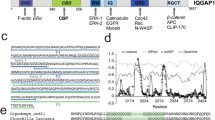Abstract
Experimentally-induced mutations in the C3HC4 RING finger domain of the Bmi-1 oncoprotein block its ability to induce lymphomas in mice. In this report, the role of the Bmi-1 RING finger in mediating protein-protein interactions is examined using the yeast two-hybrid system. Bmi-1 interacts directly with the RING finger protein dinG/RING1B. Heterodimerization of the two proteins requires the intact RING finger structures of both Bmi-1 and dinG. Although the RING finger domains are necessary for dimerization, they are not sufficient for this process as residues outside the C3HC4 motif are also required. Thus, binding specificity may be partly conferred by residues outside the RING motif. Both Bmi-1 and dinG interact with the Polyhomeotic protein MPh2 through binding domains apart from the RING finger. The data suggest a model whereby Bmi-1, dinG, and MPh2 form a stable heterotrimeric complex in which each protein contributes to the binding of the others.
This is a preview of subscription content, access via your institution
Access options
Subscribe to this journal
Receive 50 print issues and online access
$259.00 per year
only $5.18 per issue
Buy this article
- Purchase on Springer Link
- Instant access to full article PDF
Prices may be subject to local taxes which are calculated during checkout
Similar content being viewed by others
Author information
Authors and Affiliations
Rights and permissions
About this article
Cite this article
Hemenway, C., Halligan, B. & Levy, L. The Bmi-1 oncoprotein interacts with dinG and MPh2: the role of RING finger domains. Oncogene 16, 2541–2547 (1998). https://doi.org/10.1038/sj.onc.1202042
Received:
Revised:
Accepted:
Published:
Issue Date:
DOI: https://doi.org/10.1038/sj.onc.1202042
Keywords
This article is cited by
-
Polycomb condensates can promote epigenetic marks but are not required for sustained chromatin compaction
Nature Communications (2021)
-
Expression of stem cell factors in the adult sea cucumber digestive tube
Cell and Tissue Research (2017)
-
BMI1 attenuates etoposide-induced G2/M checkpoints via reducing ATM activation
Oncogene (2015)
-
The polycomb protein MPc3 interacts with AF9, an MLL fusion partner in t(9;11)(p22;q23) acute leukemias
Oncogene (2001)
-
Mmip-2, a novel RING finger protein that interacts with mad members of the Myc oncoprotein network
Oncogene (1999)



